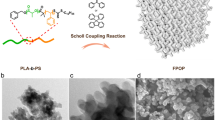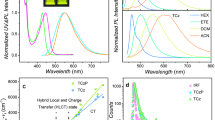Abstract
Conjugated microporous polymers (CMPs) are a kind of porous skeleton polymers, which are characterized by extended conjugated skeletons, large specific surface area and structure stability. In this work, a facile and versatile method was developed to fabricate flexible conjugated microporous polymer films for fast detecting the total quantity of developing agents and their oxidation products. Conjugated microporous polymer films were synthesized through in situ one-step approach by Suzuki coupling reaction. With such merits such as intense luminescence, easy synthesis and disposability, the polymer films were employed to detect developers based on fluorescence quenching in the printing wastewater. A linear response to p-benzoquinone, oxidation product of developers, was obtained in the range of 0.05–0.5 μmol·L−1, with a detection limit of 0.015 μmol·L−1. The strategy for in situ growth of flexible polyphenylene-conjugated microporous polymer (PP-CMP) films seems to be a very portable and general method for meeting different analytic purposes.






Similar content being viewed by others
References
Liu Q, Tang Z, Wu M, Zhou Z. Design, preparation and application of conjugated microporous polymers. Polym Int. 2014;63:381–92.
James SL. Metal-organic frameworks. Chem Soc Rev. 2003;32:276.
Férey G. Hybrid porous solids: past, present, future. Chem Soc Rev. 2008;37:191–214.
Dawson R, Cooper AI, Adams DJ. Chemical functionalization strategies for carbon dioxide capture in microporous organic polymers. Polym Int. 2012;62:345–52.
Dawson R, Adams DJ, Cooper AI. Chemical tuning of CO2 sorption in robust nanoporous organic polymers. Chem. Sci. 2011;2:1173–7.
Su F, Bray CL, Carter BO, Overend G, Cropper C, Iggo JA, Khimyak YZ, Fogg AM, Cooper AI. Reversible hydrogen storage in hydrogel clathrate hydrates. Adv Mater. 2009;21:2382–6.
Li A, Sun H, Tan D, Fan W, Wen S, Qing X, Li G, Li S, Deng W. Superhydrophobic conjugated microporous polymers for separation and adsorption. Energ Environ Sci. 2011;4:2062–5.
Chen L, Yang Y, Jiang D. CMPs as scaffolds for constructing porous catalytic frameworks: a built-in heterogeneous catalyst with high activity and selectivity based on nanoporous metalloporphyrin polymers. J Am Chem Soc. 2010;132:9138–43.
Sprick RS, Jiang J, Bonillo B, Ren S, Ratvijitvech T, Guiglion P, Zwijnenburg MA, Adams DJ, Cooper AI. Tunable organic photocatalysts for visible-light-driven hydrogen evolution. J Am Chem Soc. 2015;137:3265–70.
Liu J, Yee K, Kam-Wing K, Zhang KY, To W, Che C, Xu Z. Selective Ag (I) binding, H2S sensing, and white-light emission from an easy-to-make porous conjugated polymer. J Am Chem Soc. 2014;136:2818–24.
Lee W, Jin Y, Park L, Kwak G. Fluorescent actuator based on microporous conjugated polymer with intramolecular stack structure. Adv Mater. 2012;24:5604–9.
Xu Y, Nagai A, Jiang D. Core–shell conjugated microporous polymers: a new strategy for exploring color-tunable and -controllable light emissions. Chem Commun. 2013;49:1591–3.
Urakami H, Zhang K, Vilela F. Modification of conjugated microporous poly-benzothiadiazole for photosensitized singlet oxygen generation in water. Chem Commun. 2013;49:2353–5.
Chen L, Honsho Y, Seki S, Jiang D. Light-harvesting conjugated microporous polymers: rapid and highly efficient flow of light energy with a porous polyphenylene framework as antenna. J Am Chem Soc. 2010;132:6742–8.
Pan J, Jia S, Li G, Hu Y. Organic building block based microporous network SNW-1 coating fabricated by multilayer interbridging strategy for efficient enrichment of trace volatiles. Anal Chem. 2015;87:3373–81.
Zhou L, Hu Y, Li G. Conjugated microporous polymers with built-in magnetic nanoparticles for excellent enrichment of trace hydroxylated polycyclic aromatic hydrocarbons in human urine. Anal Chem. 2016;88:6930–8.
Zhang Y, Sigen A, Zou Y, Luo X, Li Z, Xia H, Liu X, Mu Y. Gas uptake, molecular sensing and organocatalytic performances of a multifunctional carbazole-based conjugated microporous polymer. J Mater Chem A. 2014;2:13422.
Wei J, Zhang X, Zhao Y, Li R. Chiral conjugated microporous polymers as novel chiral fluorescence sensors for amino alcohols. Macromol Chem Phys. 2013;214:2232–8.
Zhang P, Guo J, Wang C. Magnetic CMP microspheres: multifunctional poly (phenylene ethynylene) frameworks with covalently built-in Fe3O4 nanocrystals exhibiting pronounced sensitivity for acetaminophen microdetection. J Mater Chem. 2012;22:21426–33.
Gopalakrishnan D, Dichtel WR. Direct detection of RDX vapor using a conjugated polymer network. J Am Chem Soc. 2013;135:8357–62.
Dichtel JLN, Dichtel WR. Conjugated porous polymers for TNT vapor detection. ACS Macro Lett. 2013;2:423–6.
Liu X, Xu Y, Jiang D. Conjugated microporous polymers as molecular sensing devices: microporous architecture enables rapid response and enhances sensitivity in fluorescence-on and fluorescence-off sensing. J Am Chem Soc. 2012;134:8738–41.
Gopalakrishnan D, Dichtel WR. Real-time, ultrasensitive detection of RDX vapors using conjugated network polymer thin films. Chem Mater. 2015;27:3813–6.
Enguita FJ, Leitao AL. Hydroquinone: environmental pollution, toxicity, and microbial answers. Biomed Res. Int. 2013;2013:542168.
Lin C, Sheu J, Wu H, Huang YJ. Determination of hydroquinone in cosmetic emulsion using microdialysis sampling coupled with high-performance liquid chromatography. Pharm Biomed. 2005;38:414–9.
Sirajuddin, Bhanger MI, Niaz A, Shah A, Rauf A. Ultra-trace level determination of hydroquinone in waste photographic solutions by UV–vis spectrophotometry. Talanta. 2007;72:546–53.
Chao Y, Zhang X, Liu L, Tian L, Pei M, Cao W. Determination of hydroquinone by flow injection chemiluminescence and using magnetic surface molecularly imprinted particles. Microchim Acta. 2015;182:943–8.
Upan J, Reanpang P, Chailapakul O, Jakmunee J. Flow injection amperometric sensor with a carbon nanotube modified screen printed electrode for determination of hydroquinone. Talanta. 2016;146:766–71.
Yuan X, Yuan D, Zeng F, Zou W, Tzorbatzoglou F, Tsiakaras P, Wang Y. Preparation of graphitic mesoporous carbon for the simultaneous detection of hydroquinone and catechol. Appl. Catal. B-Environ. 2013;129:367–74.
Yang H, Ting H, Shih Y. Self-validated detection of hydroquinone in medicated cosmetic products using a preanodized screen-printed ring disk carbon electrode. Anal Methods UK. 2016;8:5495–502.
Acknowledgements
The work were supported by the National Natural Science Foundation of China (Nos. 21575168, 21277176, 21475153 and 21675178), the Guangdong Provincial Natural Science Foundation of China (No. 2015A030311020), the Special Funds for Public Welfare Research and Capacity Building in Guangdong Province of China (No. 2015A030401036), and the Guangzhou Science and Technology Program of China(No. 201604020165), respectively.
Author information
Authors and Affiliations
Corresponding authors
Additional information
L. Zhou and Y. Peng contributed equally to this paper.
About this article
Cite this article
Zhou, L., Peng, Y., Hu, Y. et al. In Situ Growth of Flexible Polyphenylene-Conjugated Microporous Polymer Films for Fluorescence Detection of the Total Quantity of Developing Agents and Their Oxidation Products. J. Anal. Test. 1, 5 (2017). https://doi.org/10.1007/s41664-017-0006-8
Received:
Accepted:
Published:
DOI: https://doi.org/10.1007/s41664-017-0006-8




